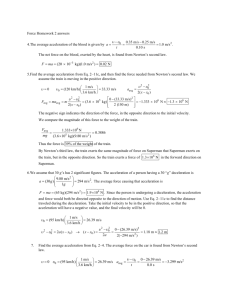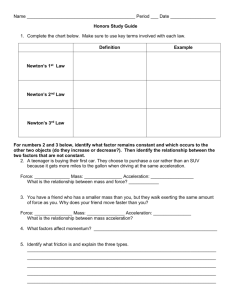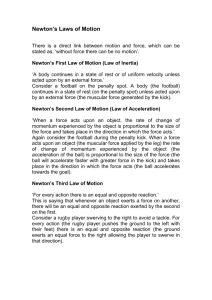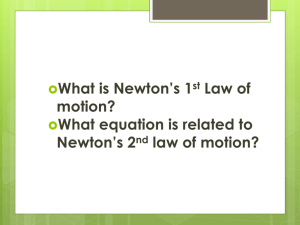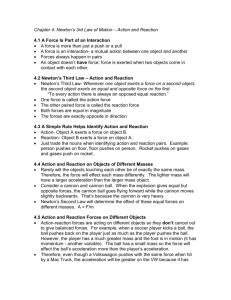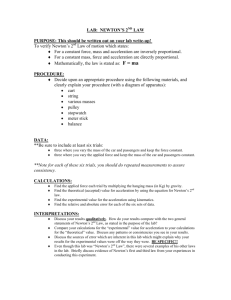Newton Law Notes
advertisement
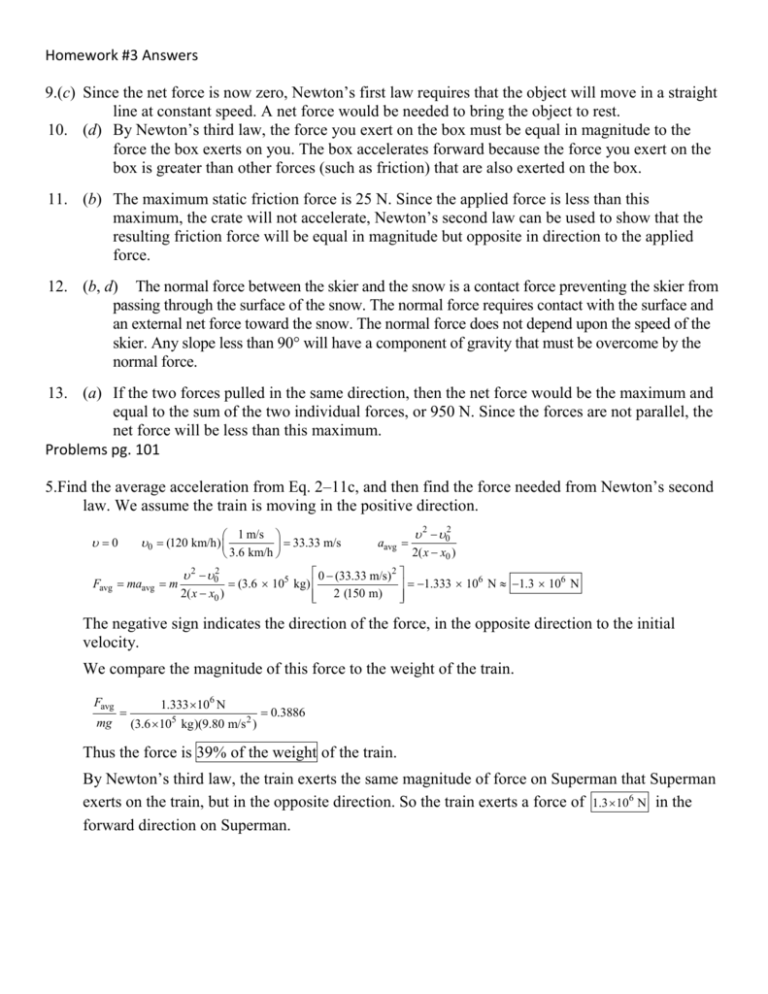
Homework #3 Answers 9.(c) Since the net force is now zero, Newton’s first law requires that the object will move in a straight line at constant speed. A net force would be needed to bring the object to rest. 10. (d) By Newton’s third law, the force you exert on the box must be equal in magnitude to the force the box exerts on you. The box accelerates forward because the force you exert on the box is greater than other forces (such as friction) that are also exerted on the box. 11. (b) The maximum static friction force is 25 N. Since the applied force is less than this maximum, the crate will not accelerate, Newton’s second law can be used to show that the resulting friction force will be equal in magnitude but opposite in direction to the applied force. 12. (b, d) The normal force between the skier and the snow is a contact force preventing the skier from passing through the surface of the snow. The normal force requires contact with the surface and an external net force toward the snow. The normal force does not depend upon the speed of the skier. Any slope less than 90° will have a component of gravity that must be overcome by the normal force. 13. (a) If the two forces pulled in the same direction, then the net force would be the maximum and equal to the sum of the two individual forces, or 950 N. Since the forces are not parallel, the net force will be less than this maximum. Problems pg. 101 5.Find the average acceleration from Eq. 2–11c, and then find the force needed from Newton’s second law. We assume the train is moving in the positive direction. 2 02 1 m/s 0 (120 km/h) aavg 33.33 m/s 2( x x0 ) 3.6 km/h 0 (33.33 m/s) 2 2 02 6 6 maavg m (3.6 105 kg) 1.333 10 N 1.3 10 N 2( x x0 ) 2 (150 m) 0 Favg The negative sign indicates the direction of the force, in the opposite direction to the initial velocity. We compare the magnitude of this force to the weight of the train. Favg mg 1.333 106 N (3.6 105 kg)(9.80 m/s 2 ) 0.3886 Thus the force is 39% of the weight of the train. By Newton’s third law, the train exerts the same magnitude of force on Superman that Superman exerts on the train, but in the opposite direction. So the train exerts a force of 1.3 106 N in the forward direction on Superman. 7. Find the average acceleration from Eq. 2–4. The average force on the car is found from Newton’s second law. 0 0 26.39 m/s 1 m/s 3.299 m/s2 26.39 m/s aavg t 8.0 s 3.6 km/h 0 0 (95 km/h) Favg maavg (950 kg)(3.299 m/s2 ) 3134 N 3100 N The negative sign indicates the direction of the force, in the opposite direction to the initial velocity. 9. The problem asks for the average force on the glove, which in a direct calculation would require knowledge about the mass of the glove and the acceleration of the glove. But no information about the glove is given. By Newton’s third law, the force exerted by the ball on the glove is equal and opposite to the force exerted by the glove on the ball. So we calculate the average force on the ball, and then take the opposite of that result to find the average force on the glove. The average force on the ball is its mass times its average acceleration. Use Eq. 2–11c to find the acceleration of the ball, with 0, 0 35.0 m/s, and x x0 0.110 m. The initial velocity of the ball is the positive direction. aavg 2 02 2( x x0 ) 0 (35.0 m/s)2 5568m/s2 2(0.110 m) Favg maavg (0.140 kg)(5568 m/s2 ) 7.80 102 N
